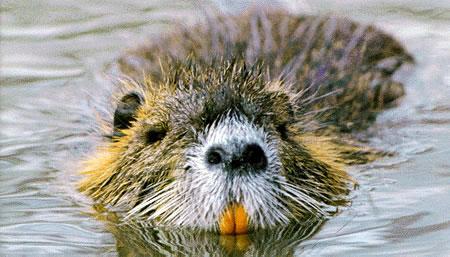Description and Range
Physical description
Nutria are semi-aquatic rodents native to southern parts of South America. In the 1930s, they were sold throughout North America to fur farmers and as a means of controlling unwanted aquatic vegetation. Various associations, magazine and newspaper articles, and demonstrations at county fairs promoted the sale of nutria in Washington. Adult nutria average 24 inches long from the nose to the base of the tail. The tail itself is 12-16 inches long, round, and nearly hairless. Males are slightly larger than females; males weigh 12-20 pounds and females weigh 10-18 pounds. Depending on the nutria’s ancestry and current habitat, its fur will vary from light yellowish brown to dark reddish brown, and black. Their hind legs are much larger than the forelegs. When moving on land, a nutria may drag its chest and appear to hunch its back.
Geographic range
Nutria are found in lakes, wetlands, sloughs, drainage ditches, and irrigation canals along the Columbia River and north to Skagit County. Cold temperatures seem to reduce the distribution of nutria, as they don’t live in areas where water surfaces freeze for long periods.
Living with wildlife
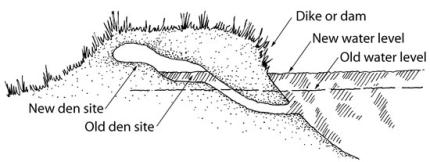
Nutria are active throughout the year. Although they may be seen at any time, they are most active at twilight and throughout the night. They may be seen feeding during the day when food is scarce, or basking in the sun when temperatures are low.
Nutria generally occupy a small area throughout their lives. Daily travel distances for most nutria are less than 600 feet, although some individuals may travel much farther. Rarely will nutria be seen very far from water, and they are usually seen swimming. They tend to swim with their narrow, pointed tails snaking in the water behind them, or arched out of the water; you never see a beaver’s rounded tail as it swims.
When startled, nutria enter the water with a loud splash, and, being strong swimmers, they may swim long distances underwater before surfacing. (Nutria can remain submerged for as long as 10 minutes.) They can also remain motionless under sparse vegetation, with only their noses and eyes above water.
When cornered or captured, nutria are aggressive biters and scratchers and can seriously injure pets and humans.
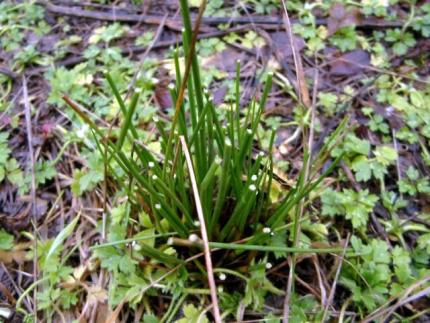
Feeding Areas
Evidence of nutria feeding includes rushes, sedges and other plants gnawed to a stubble, floating cattail roots or other vegetation that has been clipped, and piles of clipped vegetation under overhanging vegetation or in a well-concealed spot at the water’s edge.
Nutria often build flattened circular feeding platforms of vegetation in shallow water. Constructed of coarse emergent vegetation, these platforms are also used for loafing, grooming, and birthing and are often misidentified as muskrat houses. Feeding platforms measure 3 to 6 feet across and there may be travel channels through the mud leading to them
Tracks
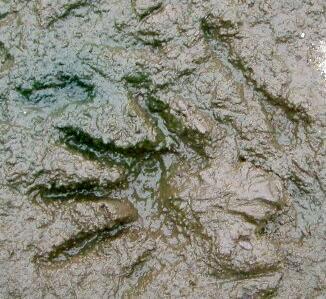
Nutria tracks can be found in mud or sand along shorelines (Fig. 4). The mark of a dragging tail is sometimes apparent.
Nutria have five clawed toes on each foot; the front feet are not webbed. Nutria tracks are easily confused with beaver tracks when the beaver’s fifth toe webbing does not print.
Droppings
Nutria droppings are dark green, brown, or almost black. Nutria droppings are 2 inches long and 1/2 inch in diameter. The droppings are unique in that they have distinct parallel grooves along their entire length, making them distinguishable from droppings of muskrat and beaver.
Nutria droppings can be found floating in the water, along shorelines, on objects protruding out of the water, and at feeding sites. The animals may repeatedly use these spots, and more than one nutria may use the same spot.
Slides
Slides are the narrow trails nutria make where they enter and leave the water. Nutria slides are twice the width of a hand. (Beaver slides can be up to 20 inches wide.) Slides look like muddy trails and may be slicked down from the animals’ sliding down them on their bellies.
Calls
Where large numbers of nutria are present at dusk, a chorus of pig-like grunts may be heard.
Preventing conflict
Nutria damage is related to burrowing and feeding. Nutria construct burrows in the banks of rivers, sloughs, and ponds, sometimes causing considerable erosion. Burrows can weaken roadbeds, stream banks, dams, and dikes, which may collapse when the soil is saturated by rain or high water. Rain action can wash out and enlarge collapsed burrows and compounds the damage.
Their large size makes it possible for nutria to girdle orchard trees, landscape trees, and ornamental shrubs.
Nutria numbers may increase to the point where an area is denuded of aquatic vegetation. After foraging on entire plants, including the roots, they leave the area pitted with digging sites and deep swimming canals. This feeding behavior can destroy existing root mats that bind and secure a wetland together, and the area can be quickly eroded by wind and wave action. In parts of southern Washington, nutria may be are out-competing muskrats for food and places to live.
The following suggestions will help to reduce conflicts. You can do the work yourself or hire a company to do all or part of the work (see “Hiring a Wildlife Damage Control Company.”) In cases where these methods are not practical, contact your local County Extension Agent or Department of Agriculture’s Wildlife Services for further information.
Fences and Other Barriers
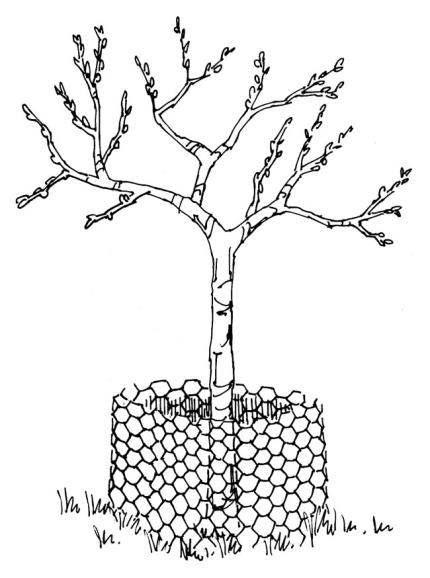
Nutria are not climbers. A properly designed and maintained 3-foot tall wire fence will exclude them. The fence must be taller if snow or other materials are likely to build up near it. Because nutria are diggers, the fence will need to extend at least 12 inches below ground. Alternately, a tight fit to the ground and an L extension that runs 24 inches out on the soil surface toward the animal will also prevent entering from underneath.
Water-Level Management
Nutria (and muskrats and Old World rats) burrow into dams, dikes, and other embankments to make dens (Fig. 9). Typically dens have 2 feet or more of earth above them. However, when fluctuating water levels flood their initial den, nutria burrow farther into the bank or dig new, higher den chambers close to the surface. In such cases this can weaken the bank, or livestock and other large animals can pierce holes in the bank, starting the erosion process.
To prevent nutria from tunneling higher in an embankment, keep fluctuations in water levels to a minimum. This can require frequently monitoring the spillway to ensure an unobstructed flow, or widening the spillway to carry off surplus water so that it never rises more than 6 inches on the dam.
Water-level manipulation can also be used to force nutria to other suitable habitat. Raising the water level in the winter to a near-flood level, and keeping it there, will force the animals out of their dens. Similarly, dropping water levels during the summer will expose nutria dens to predators, forcing them to seek a more secure area.
Slope Management

Nutria prefer to burrow on steep slopes covered with vegetation. Hence, they can be discouraged by keeping side slopes to a 3:1 or less ratio, and by controlling vegetation growth. Managing vegetation by hand can be difficult in large areas, but routine mowing or cutting with a weed whacker can be effective. Only herbicides registered for use next to water should be used, and then only per the manufacture’s recommendations.
If possible, keep livestock off embankments to avoid the chance that an animal will put a hoof through a den chamber. If a roof is pierced, immediately fill in the cavity with soil, rocks, or a mudpack (see below).
Embankment Barriers
A wire or stone barrier installed 1 foot above to 3 feet below normal water level can prevent nutria from burrowing into an earth embankment.
A barrier can be made from 1-inch mesh hardware cloth (aluminum and stainless steel are also available), or heavy-duty plastic or fiberglass netting. The barrier should be placed flat against the bank and anchored every few feet along all edges. To extend the life of galvanized hardware cloth, spray it with automobile undercoat paint or other rustproof paint before installation. Since the wire will eventually corrode, do not use this material where people are likely to swim.
Riprapping areas with stone creates an effective barrier and protect slopes from wave action. Stone should be at least 6 inches thick.
Where a burrowing problem is extreme, use a gas-powered trenching machine (available at rental stores) to dig a narrow trench along the length of the embankment. Hand digging will be required to dig to the recommended depth—3 feet below the high-water level. Next, fill the trench with a mudpack. A mudpack is made by adding water to a 90 percent earth and 10 percent cement mixture until it becomes a thick slurry. The resulting solid core will prevent nutria from digging through the embankment.
Harassment and Repellents
Nutria are wary animals and will try to escape when threatened. When new burrows are discovered early on, the entry holes can be stuffed with rocks, balled-up window screen, and/or rags sprinkled with predator urine (mink, coyote, or bobcat—available from trapper supply outlets and over the Internet). Some people have had success using old cat litter in this way. Exposing their tunnels from above may also work. The success of this type of control depends on persistence from the harasser and thus is often short-lived.
Loud noises, high-pressure water sprays, and other types of harassment have been used to scare nutria from lawns and golf courses. However, the success of this type of control is usually short-lived and problem animals soon return. Large dogs that are awake during the night can be effective at keeping nutria out of areas. Bold nutria often intimidate small dogs.
Crop Location
Unfenced crops and gardens located close to water will be more attractive to nutria than those further from water. If you have a choice of where to locate your garden, consider nutria damage. Natural vegetation buffers next to water bodies can provide feeding areas and reduce the attractiveness of vegetation further from the water.
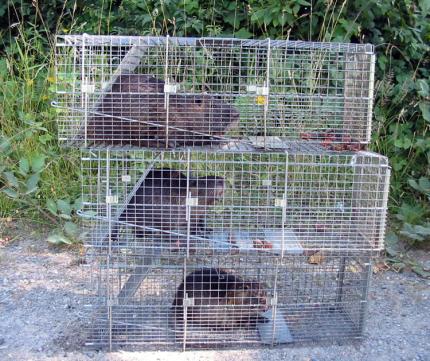
Trapping and Lethal Control
Nutria are easily captured in single door three or four foot long live traps. Bait live traps with sweet potatoes or carrots and place them along active trails or wherever nutria or their sign are seen. A small amount of bait leading to the entrance of the live trap will increase capture success.
Due to its classification as a Prohibited Aquatic Animal Species (see “Legal Status”), all live-trapped nutria should be euthanized and not returned to the wild.
When cornered or captured, nutria are aggressive and can inflict serious injury to pets and humans. Extreme care should be taken when handling captured nutria.
Trapping may not be legal in some urban areas; check with local authorities. See Trapping Wildlife for additional information, including euthanization.
Since nutria are usually found in waterways, there is often an unlimited supply of replacement animals upstream and downstream from where the damage is occurring. Rapid immigration coupled with a high reproductive rate makes ongoing lethal control a “high-effort” method of damage control that is often ineffective. (Lethal control can be effective in areas where the local population of nutria is still small.) The methods described and referenced in “Preventing Conflicts” are the best long-term solution.
Shooting has been an effective in eliminating small isolated groups of nutria. For safety considerations, shooting is generally limited to rural situations and is considered too hazardous in more populated areas, even if legal. No fumigants are currently registered for nutria control.
Public Health Concerns
Nutria, rabbits, hares, voles, muskrats, and beavers are some of the species that can be infected with the bacterial disease tularemia. Tularemia is fatal to animals and is transmitted to them by ticks, biting flies, and via contaminated water. Animals with this disease may be sluggish, unable to run when disturbed, or appear tame.
Tularemia may be transmitted to humans if they drink contaminated water, eat undercooked, infected meat, or allow an open cut to contact an infected animal. The most common source of tularemia for humans is to be cut or nicked by a knife when skinning or gutting an infected animal. Humans can also get this disease via a tick bite, a biting fly, ingestion of contaminated water, or by inhaling dust from soil contaminated with the bacteria.
A human who contracts tularemia commonly has a high temperature, headache, body ache, nausea, and sweats. A mild case may be confused with the flu and ignored. Humans can be easily treated with antibiotics.
Nutria are among the few animals that regularly defecate in water, and their droppings (like those of humans and other mammals) may cause a flu-like infection when contaminated water is ingested. The technical name for this illness is “giardiasis.” It is more commonly referred to as “giardia”—derived from giardia, the single-cell protozoa that causes the disease. Another popular term, “beaver fever,” may be a misnomer. It has never been demonstrated that the type of giardia beavers carry causes giardiasis in humans. Giardia has been found in many animal species, including pets, wildlife, and livestock.
Anyone handling a dead or live nutria should wear rubber gloves, and wash his or her hands well when finished.
Legal Status
The nutria is classified as a Prohibited Aquatic Animal Species (WAC 220-12-090). Due to this classification, all live-trapped nutria should be euthanized and not returned to the wild. (See Trapping Wildlife for information, including euthanization.)
No special trapping permit is necessary for the use of live traps. However, a special trapping permit is required for the use of all traps other than live traps (RCW 77.15.192, 77.15.194; WAC 220-417-040). There are no exceptions for emergencies and no provisions for verbal approval. All special trapping permit applications must be in writing on a form available from the Department of Fish and Wildlife (WDFW).
It is unlawful to transport nutria, and all other wildlife, anywhere within the state without a permit to do so (RCW 77.15.250; WAC 220-450-010).
